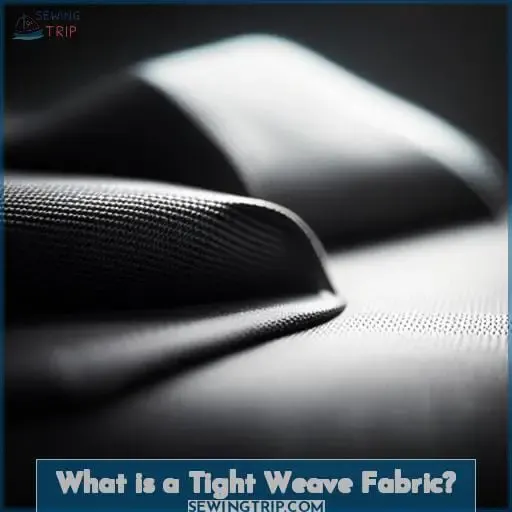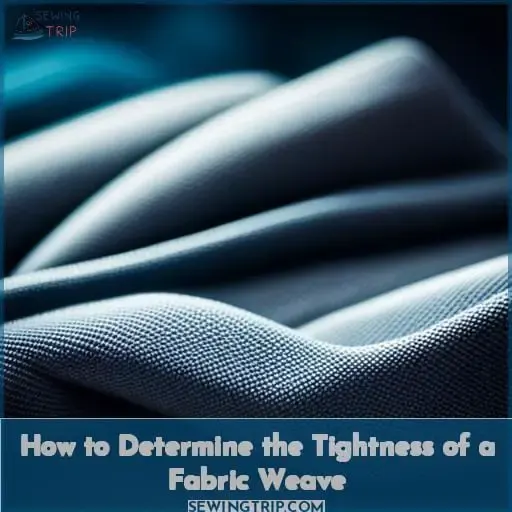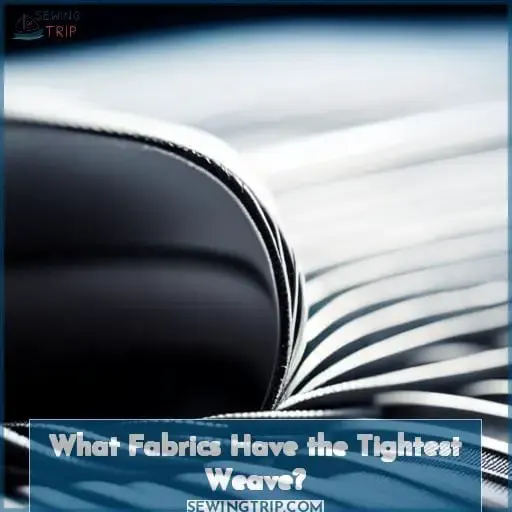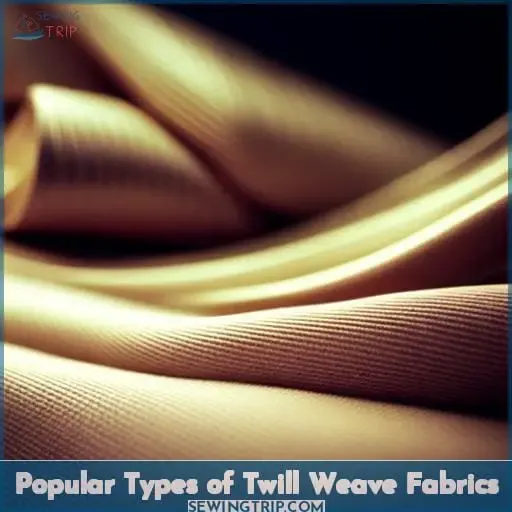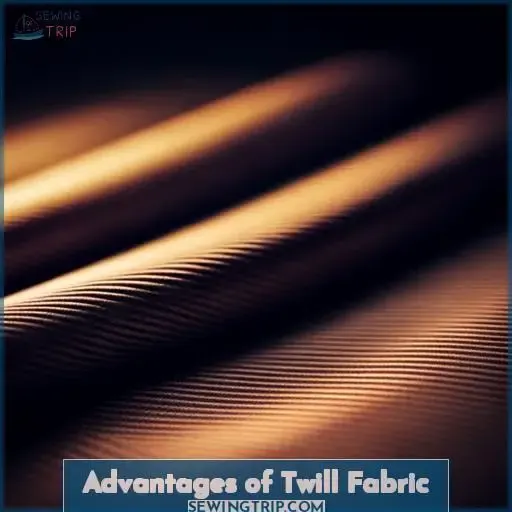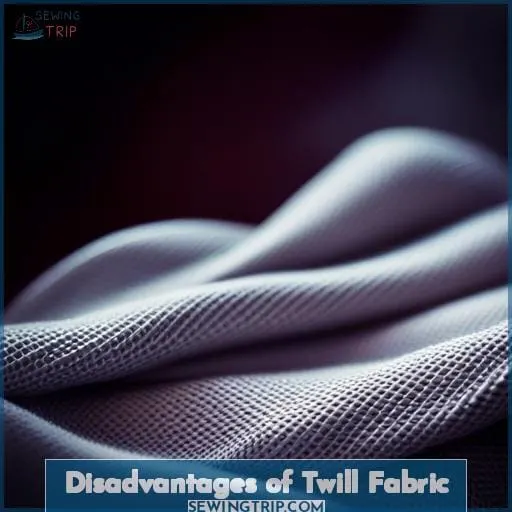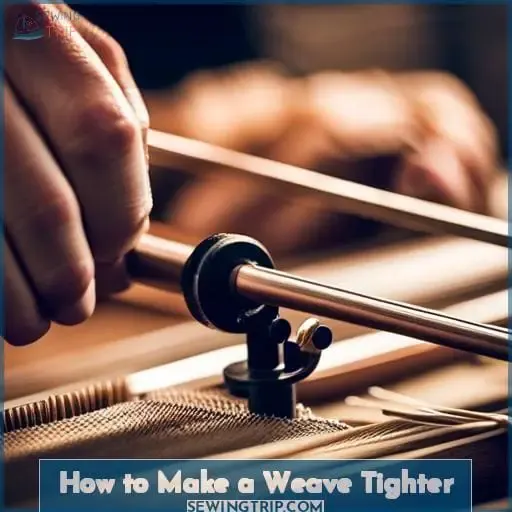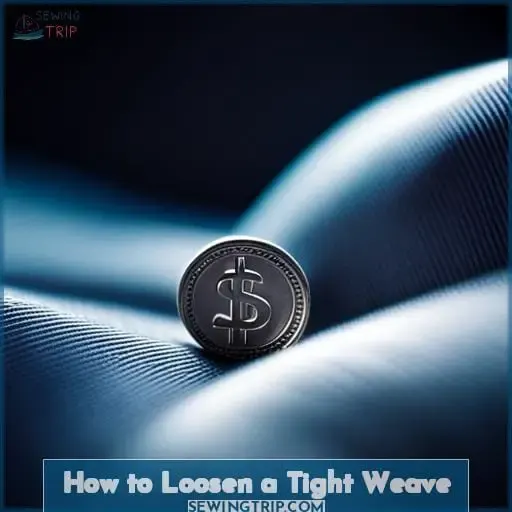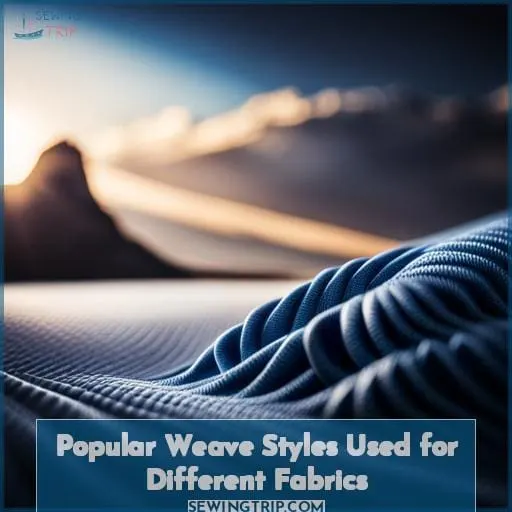This site is supported by our readers. We may earn a commission, at no cost to you, if you purchase through links.
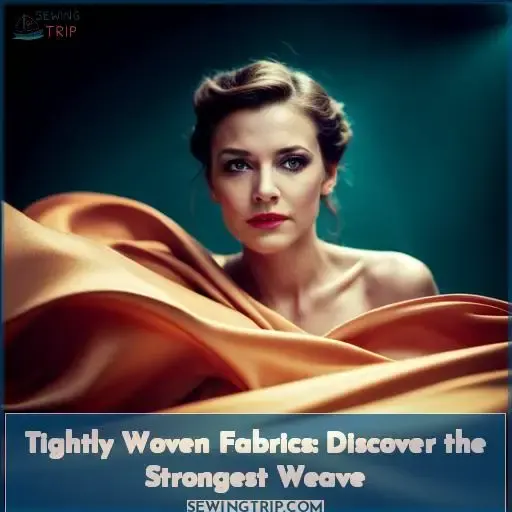 Imagine diving into the world of tightly woven fabrics, where strength and durability intertwine to create a fabric that stands the test of time.
Imagine diving into the world of tightly woven fabrics, where strength and durability intertwine to create a fabric that stands the test of time.
In this article, you will uncover the secrets behind the strongest weaves and unravel their characteristics. From twill to herringbone, explore popular types of tightly woven fabrics and discover how they can enhance your clothing or home decor projects.
Get ready to delve into a realm where threads are meticulously crafted together for ultimate resilience and style.
Table Of Contents
- Key Takeaways
- What is a Tight Weave Fabric?
- How to Determine the Tightness of a Fabric Weave
- What Fabrics Have the Tightest Weave?
- Characteristics of Twill Fabric
- Popular Types of Twill Weave Fabrics
- Advantages of Twill Fabric
- Disadvantages of Twill Fabric
- How to Make a Weave Tighter
- How to Loosen a Tight Weave
- Popular Weave Styles Used for Different Fabrics
- Frequently Asked Questions (FAQs)
- Conclusion
Key Takeaways
- Tight weave fabric has minimal space between woven threads and provides excellent water resistance, thermal insulation, wind resistance, wrinkle resistance, and moisture-wicking properties.
- Fabrics such as muslin, flannel, and twill have a tight weave.
- Twill fabric is known for its durability, softness, soil resistance, and versatility due to its tight weave structure.
- Twill fabric has abrasion resistance, water resistance, wrinkle resistance, tear resistance, and a soft texture with good drapability.
What is a Tight Weave Fabric?
If you’re wondering what defines a tight weave fabric, it can be described as a material that has minimal space between its woven threads.
This type of fabric is known for its ability to provide excellent:
- Water resistance
- Thermal insulation
- Wind resistance
- Wrinkle resistance
- Moisture-wicking properties
The tight weave creates a barrier that prevents water from penetrating the fabric and allows it to bead up on the surface instead. It also helps trap air pockets within the fabric structure, enhancing thermal insulation capabilities.
Additionally, the closely spaced threads make it difficult for wind to penetrate through the fabric.
The result is a durable and versatile material that offers superior performance in various applications such as outerwear garments or home textiles where protection against environmental elements is essential.
How to Determine the Tightness of a Fabric Weave
To determine the tightness of a fabric weave, hold it up to the sun or a light source and observe how much light gets through. A tightly woven fabric will allow very little to no light to pass through, indicating a tight weave.
Here are three ways you can assess the tightness of a fabric:
- Light Test: Hold the fabric up against sunlight or any other strong light source.
- Thread Count: Check the number of threads going vertically and horizontally in one square inch of fabric. The higher the thread count, typically indicated on labels as TC, indicates tighter weaving.
3.Tactile Test: Feel for thickness and stiffness when touching fabrics like duck cloth (also known as canvas), polyester weaves with high density polyester fibers that offer strength while maintaining breathability
These methods provide valuable insights into determining whether your chosen material possesses an optimal level of durability and protection due to its tightly woven structure.
What Fabrics Have the Tightest Weave?
When determining which fabrics have the tightest weave, it’s important to consider their thread count and how much light passes through them.
Fabrics with a high thread count usually have a tighter weave because they contain more threads per square inch. This results in less space for air or light to pass through, making the fabric denser and stronger.
Additionally, tightly woven fabrics tend to be more durable as they’re less likely to fray or tear easily.
Some examples of fabrics known for their tight weave include muslin, flannel, and twill.
Muslin is breathable yet tightly woven, while flannel provides warmth due to its dense structure.
Twill is another option that offers both durability and wrinkle resistance along with its tight weave construction.
Characteristics of Twill Fabric
Twill fabric is known for its durability, softness, soil resistance, and versatility.
With a tight weave structure that has fewer interlacing threads than other weaves, twill fabric withstands wear and tear while maintaining its smooth texture.
Its ability to resist soiling makes it a practical choice for various applications, from clothing to upholstery.
Durability
Twill fabric, known for its durability and versatility, offers a strong and long-lasting option for tightly woven fabrics.
Its tight weave enhances abrasion resistance and tear resistance, making it highly durable against wear and tear.
Twill also exhibits water resistance to some extent due to the compact structure of its weave.
Additionally, twill fabrics are generally mildew resistant and can provide some level of flame resistance depending on the specific type of twill weave used.
Softness
You’ll love the softness of twill fabric, known for its luxurious feel and comfortable wear.
The drape of twill fabric enhances its softness, allowing it to flow gracefully when worn.
Not only does twill provide a cozy warmth during cooler months, but it also offers breathability for comfort in warmer weather.
Additionally, the unique weave pattern of twill lends itself to excellent wrinkle resistance and durability, ensuring that your garments maintain their softness over time.
Soil Resistance
Keep your fabrics looking clean and fresh with twill fabric’s exceptional resistance to soiling.
Twill fabric is known for its water resistance, making it resistant to water-based stains and spills.
Additionally, the tightly woven structure of twill makes it naturally repellent to oils and other substances that can cause staining. This makes twill fabric a great choice for upholstery, clothing, and other applications where stain resistance is important.
Furthermore, the dense weave of twill also provides mildew resistance by limiting moisture absorption into the fabric fibers.
Versatility
When choosing a fabric for your projects, consider the versatility of twill fabric.
Twill is known for its ability to blend well with other fabrics, materials, colors, patterns, and designs.
Whether you want to mix it with silk or cotton blends, incorporate different textures or prints into your design, twill fabric can easily adapt and complement various elements of your project.
Its flexibility allows you to create unique and diverse garments that showcase your creativity and style.
Popular Types of Twill Weave Fabrics
When it comes to popular types of twill weave fabrics, there are several options to consider.
- Foulard
- Herringbone
- Houndstooth
- Serge
- Sharkskin
These fabrics have a tight weave structure which contributes to their durability and versatility in various applications such as clothing or upholstery.
Foulard
Continue exploring the characteristics of twill fabric with a look at one of its popular types: the foulard.
The foulard has a long history and is known for its distinct patterns and designs.
Foulards are lightweight fabrics, making them ideal for clothing such as dresses, blouses, and scarves. They require delicate care to maintain their vibrant colors and intricate designs.
- Foulard history
- Foulard vs. herringbone
- Lightweight foulards
- Care instructions for foulards
- Uses of foulards
Herringbone
As you explore tightly woven fabrics, one popular type of twill weave fabric to consider is herringbone.
Herringbone fabric has a distinct pattern that resembles the bones of a fish, giving it its name. It’s known for its strength and durability, making it suitable for various applications.
The weight of herringbone fabric can vary depending on the materials used, but it generally falls within the medium to heavy range.
The texture of herringbone fabric adds visual interest with its zigzag pattern created by diagonal rows of parallel lines. This versatile fabric can be found in various patterns and colors to suit different styles and preferences.
Houndstooth
To explore more popular types of twill weave fabrics, let’s dive into the classic pattern known as houndstooth.
Houndstooth originated in Scotland and was traditionally used for outerwear, such as coats and jackets. It’s characterized by its distinctive broken-check pattern, which resembles the teeth of a dog (hence the name).
Houndstooth patterns can vary in size and color combinations, offering versatility for different styles and preferences. This fabric is typically medium to heavy weight, making it suitable for colder weather garments.
When caring for houndstooth fabrics, it’s recommended to follow specific care instructions provided by manufacturers or consult with professionals if unsure about proper cleaning methods.
Some well-known brands that incorporate houndstooth designs include Burberry and Chanel.
Serge
If you want a fabric with a strong and durable weave, consider serge.
Serge is a type of twill weave fabric that has been used for centuries due to its excellent durability and versatility.
It’s commonly made from wool or polyester fibers, making it suitable for different applications such as suits, uniforms, and outerwear.
Serge fabrics can vary in weight depending on the desired use.
To care for serge fabrics properly, follow the manufacturer’s instructions regarding washing and ironing temperature to maintain its quality over time.
Sharkskin
Continuing with our exploration of popular types of twill weave fabrics, let’s take a closer look at Sharkskin.
Sharkskin fabric is characterized by its unique texture that resembles the skin of a shark.
Historically, sharkskin was used in men’s suits for its durability and elegant sheen. Today, it’s often utilized in high-end clothing and accessories such as jackets, skirts, and handbags for its luxurious feel and sophisticated look.
Advantages of Twill Fabric
Twill fabric offers several advantages due to its unique weave structure.
Firstly, it’s highly durable, making it resistant to wear and tear over time.
Additionally, twill fabric has a soft texture that provides comfort when worn or used in various applications.
Lastly, its drapeability allows for versatile usage in different clothing and home furnishing projects.
Durable
With twill fabric, you’ll enjoy a durable weave that stands up to wear and tear. Twill fabric offers several advantages when it comes to durability:
- Abrasion resistance: Twill fabrics are known for their ability to withstand friction and resist damage from repeated use.
- Water resistance: The tight weave of twill fabric helps repel water, making it suitable for outdoor or moisture-prone applications.
- Wrinkle resistance: Due to its structure, twill fabric has natural wrinkle-resistant properties, ensuring your garments stay crisp-looking.
- Tear resistance: The diagonal pattern of the twill weave enhances the strength of the fabric, making it less prone to tearing.
Soft
Why is twill fabric considered soft?
Twill fabric has a unique structure that contributes to its softness. The diagonal pattern created by the weave gives it a smooth and supple feel, making it comfortable against the skin.
Examples of soft twill fabrics include chino, denim, and gabardine.
In addition to being soft, twill fabrics are also durable, versatile, and resistant to soiling.
Taking proper care of these fabrics will ensure their longevity and maintain their desirable properties.
Disadvantages of Twill Fabric
When considering the disadvantages of twill fabric, one important factor to consider is the higher cost of production compared to plain weaves.
The intricate design and technical front and back make it more difficult to produce and design with.
Additionally, after being laundered, twill fabric can be prone to twisting and improper hang, requiring extra care during maintenance.
Cost of Production
Now let’s talk about the cost of producing twill fabric, which can present some disadvantages in terms of expenses.
Twill fabrics tend to have higher production costs compared to plain weaves due to their complex weaving structure.
The technical front and back of twill fabric make it more difficult and time-consuming to design and produce.
Additionally, after being laundered, twill fabrics are prone to twisting and may not hang properly, requiring extra care during production processes.
Design and Production Challenges
When designing and producing twill fabric, you may encounter challenges due to its technical front and back.
The technical face and back of twill fabric have fewer interlacing threads compared to other weave types.
Additionally, twill fabrics are more expensive to produce than plain weaves.
They can be more difficult to design due to the specific requirements of the technical front and back.
Twisting and improper hang after laundering can also pose challenges with this type of fabric.
Post-Laundering Issues
After laundering twill fabric, you may encounter certain issues that can affect its appearance and hang.
Twill fabrics are prone to:
- Twisting
- Puckering
- Stretching
- Shrinkage
- Uneven drying
These post-laundering problems can lead to distorted patterns or unevenness in the fabric’s weave.
It’s important to follow proper care instructions when washing twill fabrics to minimize these disadvantages and maintain the integrity of the weave.
How to Make a Weave Tighter
To make a weave tighter, you can increase the number of interlacing threads in both the warp and weft directions.
Here are three ways to achieve a tighter weave:
- Use more threads: By adding more threads in each direction, you increase the density of the fabric and create a tighter weave.
- Use heavier weight thread: Thicker or heavier weight thread will naturally result in a denser fabric with less space between each interlacing thread.
- Use more tension: Applying greater tension while weaving helps pull the threads closer together, creating a tight and compact woven structure.
By implementing these techniques, such as using finer thread or working on smaller looms, you can effectively tighten your fabric’s weave for enhanced strength and durability. Remember that achieving different levels of tightness depends on various factors such as material properties and desired outcome.
How to Loosen a Tight Weave
If you want to loosen a tight weave, you can try using steam to relax the fabric fibers. The heat and moisture from the steam will help to soften and expand the tightly woven threads, making them easier to manipulate.
-
Steam:
- Hold a steamer or iron several inches away from the fabric and gently pass it over the surface in sweeping motions.
- Be sure not to get too close or apply too much heat as this may damage certain fabrics.
-
Hot water soak:
- Fill a basin with hot water (not boiling) and submerge your garment for about 15-30 minutes.
- This will allow the fibers of the fabric to relax and loosen up.
3.Vinegar solution hand wash:
- Mix equal parts vinegar with lukewarm water in a basin or sink, then gently agitate your garment in this solution for about 10-15 minutes before rinsing thoroughly.
Remember that not all fabrics respond well to these methods, so it’s always best practice first consult manufacturer guidelines on whether an item is suitable for home treatment like these or if professional dry cleaning is recommended instead.
Popular Weave Styles Used for Different Fabrics
Now let’s explore popular weave styles that are commonly used for different fabrics.
One of the most common and versatile weave styles is the plain weave, which consists of a simple over-under pattern. This type of weave creates a balanced and durable fabric with good breathability.
Another popular choice is the basket weave, characterized by its crisscrossed yarns that create a checkerboard-like appearance. Basket weaves provide excellent strength and stability to fabrics like canvas or upholstery materials.
Twill weaves are another widely-used style known for their diagonal lines or ridges formed by interlacing yarns in a progressive manner. Twill woven fabrics such as denim, herringbone, or serge offer durability along with softness and drapability.
Satin weaves produce luxurious smooth surfaces due to long floats on one side resulting from an irregular interlacing pattern between warp (vertical) and weft (horizontal) threads. Satin-woven silk or polyester fabrics have an elegant sheen but can be prone to snagging.
Lastly, there’s the herringbone weave which features V-shaped patterns resembling fishbones created through alternating diagonal passes of warp threads forming distinctive chevron designs often seen in tweed garments.
Understanding these popular weaving techniques will help you choose suitable fabric types based on their desired characteristics such as strength, texture, drape ability,and visual appeal
Frequently Asked Questions (FAQs)
How does the tightness of a fabric weave affect the durability of the fabric?
A tightly woven fabric has a higher thread count and less light passes through. This tightness contributes to the durability of the fabric by creating a stronger structure that’s more resistant to tears and wear over time.
Can a fabric with a tight weave still be breathable and comfortable to wear?
A fabric with a tight weave can still be breathable and comfortable to wear.
Fabrics like poplin, duck, and canvas have tight weaves that offer durability while allowing air circulation for comfort.
Are there any specific fabrics that are known for having an exceptionally tight weave?
Silk and polyester are known for having exceptionally tight weaves.
These fabrics offer durability, smoothness, and a glossy appearance.
With their tightly woven structures, they provide excellent resistance to light penetration and can be used in various applications requiring a high level of fabric density.
Can the tightness of a fabric weave affect the appearance and drape of the fabric?
The tightness of a fabric weave can greatly impact its appearance and drape.
A tightly woven fabric creates a smooth, refined surface that drapes elegantly, while a looser weave may result in more texture and movement.
Are there any disadvantages to using fabrics with a tight weave?
Fabrics with a tight weave, such as poplin or polyester, offer advantages like durability and resistance to soiling.
- They can be more expensive to produce
- May twist or hang improperly after laundering.
Conclusion
Ultimately, when it comes to fabrics with the tightest weave, twill fabric takes the lead. Its intricately crafted pattern not only creates a visually appealing design but also ensures exceptional durability and strength.
Twill fabric offers a soft and luxurious feel while being resistant to soil, making it a versatile choice for various clothing and home decor projects.
While twill fabric has its advantages, it’s important to consider the potential challenges and costs associated with its production.
Overall, twill weave fabrics are a reliable option for those seeking both resilience and style.

